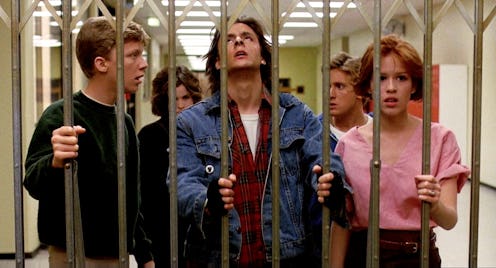Entertainment
How Does 'The Breakfast Club' Hold Up Today?

How far have we come from the days of brains, athletes, basket cases, princesses, and criminals? In 1985, these concepts rang true to audiences and critics, as did the destruction thereof at the hands of five teenagers — well, two teenagers, two 23-year-olds, and a 26-year-old — aching to prove themselves more than any singular label might understand them to be.
Thirty years later, The Breakfast Club maintains some kind of durability. Call it nostalgia (God knows the mid ’80s has all but applied for legal custody of the phenomenon), or an ironic attachment to goofy dance sequences, but there’s a reason that the John Hughes power player has earned a go at a restoration release, and that furthermore said restoration will debut at the 2015 South by Southwest Film Festival.
While The Breakfast Club has undoubtedly found intermittent big screen embodiment at any number of art house theaters over the past few decades, this new journey back into the library of Shermer High School might afford us — whether we take it in Austin on March 17 or at any one of 430 the participating theaters across America on March 26 or March 31 — a unique vantage point of the misadventures of the penalized quintet.
And from any new vantage point comes that faithful new question: Does it still work?
Is The Breakfast Club still entertaining? Undeniably. The script is still sharp, the jokes still funny, the verboten race down Shermer High halls still appropriately silly, and all parties — Emilio Estevez, Judd Nelson, Molly Ringwald, Anthony Michael Hall, and ally Sheedy (in ascending order) — are still charming.
Is The Breakfast Club still moving? Sure. Bender’s proclamation of parental abuse, Allison’s reveal of loneliness, and Brian’s admission of suicide attempt still pluck at the heartstrings (although we have over the years come to appreciate a degree of subtlety that Hughes tended to eschew when it came to his more dramatic scenes).
But, most importantly, does The Breakfast Club bear for teenagers today that indefinable character that it did for those growing up in ’85?
What does it mean for kids today to indentify as a “brain,” an “athlete,” a “basket case,” a “princess,” or a “criminal”? Archaic jargon aside (nobody’s used “brain” as a pejorative since before the movie came out — even the successive terms have been retired or reappropriated), we wonder how far youth culture has come since the starkly fissured mid-’80s. And we wonder if the sort of movies we watch today can offer any indication, just as The Breakfast Club may have done for the outsiders looking into the teen world during the Hughes era.
The most obvious shift has overtaken “nerd” culture — that which we would apply to Brian, Anthony Michael Hall’s shy, intellectual, socially awkward character. Through the glories of the all-powerful pop culture, the nerd stamp has become something of an empowering, legitimately sought after designation. The popularity of superhero films and fantasy series, resurgence of long dormant (or otherwise evasive of the mainstream spotlight) gems of film, television, or literature and the kingship afforded to those with a working knowledge thereof, has changed the game entirely for those bearing the interests we’d most strongly associate with Brian Ralph Johnson.
But what about the others? How has the advent of fantasy sports leagues and the pervasive logging of statistics change the mentality behind athleticism among teenagers? How does a frenzied institution of social feminism uproot the reliance on looks and money for which Molly Ringwald’s Claire was maligned, redirecting attention toward self-betterment, education, and ambition?
What about solitude? Is there even the possibility of being totally isolate, as Ally Sheedy’s Allison was, today, in a world where international communication is availed to anyone with a WiFi connection?
Quick answers evade us all. Yes, our society has come a long way in terms of its allocation of teenage girls into paths requesting of them only to look a certain way. Yes, it’s easier now to find likeminded friends, no matter how stifling your own high school or home life may be, by the good graces of the Internet. But we don’t need to go into all the bad you need to wade through to get there, nor do we need to suggest that American society has quite a ways to go before we can offer a genuine tip of the hat regarding the way it treats, encourages, and understands young women.
We don’t need to suggest that violence still runs rampant through the industry of professional sports, or that Emilio Estevez’s jock Andrew’s act of terror on a fellow student is an entirely antiquated notion. While the subculture of high school athleticism might not be lined with the same myopia that held the wheel during Andrew’s time, bullying — both physical and emotional — has become all the more visible thanks to America’s willingness to look for it.
Nelson’s John Bender is a question that practically answers itself. Child abuse hasn’t gone away. Patterns continue to carry through generations in abusive families.
Has the country changed since 1985? Absolutely. Do the characters we see in Breakfast Club ring a little dated? Sure. We do live in a world that loves comic books, fosters feminism, benefits from the Internet, and revels in by-the-numbers sports fandom. But the themes at the heart of the movie persist. In our own way, we’re still brains, athletes, basket cases, princesses, and criminals. We just dress a little different now…and, hopefully, we’re better dancers.
Images: Universal Pictures